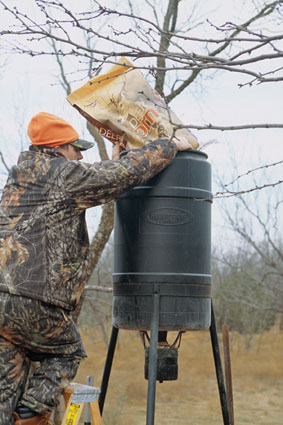 Feeders, particularly when set on a timer, allow you to control or predict when deer will visit the bait site. |
The use of bait for whitetail hunting is a divisive issue, but regardless of your feelings on the subject, there’s no doubt that a deer feeder can serve as a valuable management tool. Dr. Mickey Hellickson, chief wildlife biologist for the King Ranch in south Texas, thinks baiting is an excellent way to gauge herd health as well as to take an inventory of the bucks that are using the property. It’s also a quick and efficient way to harvest animals to meet management objectives.
“Bait can bring deer close enough for a clean, ethical and safe shot, and it allows us to take a close look at individual animals to make sure we are harvesting the ones that are best for our management plan,” he says.
Some state wildlife agencies are also realizing the value of bait. In many states, baiting is permitted for hired sharpshooters in some localities where hunting isn’t a viable option. Bait puts deer in specific places to ensure safe shots.
The Right Way To Bait
In order for baiting to work as a management tool, it has to be done properly. While many hunters simply dump corn on the ground or into a gravity feeder and return in a few days, the key to successful management with bait is to use a timed feeder, adds Kilpatrick, because deer activity will be more predictable and therefore the animals can be easier to harvest. A study conducted in Texas confirmed that deer do indeed become conditioned to the sound of a feeder.
“The first year it was legal, I placed two bags of corn on the ground and came back a couple of days later to hunt. The bait was all gone,” recalls Kilpatrick. “If it is available all the time, deer tend to visit the bait only at night.”
That’s exactly what has happened in the part of South Carolina where baiting is legal. Success rates are actually lower in the Coastal Plain, where baiting is legal, than in the other half where it isn’t. The reason? Bait is constantly available, so deer have no reason to visit a feeder during legal shooting hours. The practice of baiting is also so prevalent that the animals are in good health and therefore need to feed less.
Hellickson says his staff not only uses bait to bring animals into shooting range, but also to get an idea of the quality of animals on the land prior to the start of hunting season. Guides will dump a line of corn along a ranch road and then double back to count bucks and does and to verify the quality of bucks that come to the bait. Once they determine herd size and buck quality, they will then alter baiting methods to focus on a small area or even a specific animal. In fact, wide-scale feeding during hunting season is a common mistake hunters make, observes Hellickson.
“You don’t want to give them too much at once,” he says.
Many hunters set their feeders too far from their blinds, sometimes as far as 300 yards away — but that’s too far. If it’s done properly, a quality buck will come to a feeder 100 yards away just as quickly as he’ll come to a feeder 300 yards away. The idea is to get feeders close enough to make a clean shot and to get a good look at individual animals.
Set timed feeders to turn on under ideal shooting conditions. Many hunters set them to go off at first light or in the last 30 minutes of legal shooting time, but that can lead to a poor shot or a difficult job of following a bloodtrail in the dark.
If you hunt a small parcel of land and can’t control hunting pressure at a specific bait station, it’s a good idea to avoid over-hunting a specific spot. Otherwise deer will stop using a feeder during daylight hours. That’s exactly what Kilpatrick found when he used remote cameras to monitor deer activity around feeders.
“The more human activity there was, the less the deer used feeders during legal shooting hours,” he concludes. “Once we backed off and left the feeders alone, deer started coming in during the daytime.”






